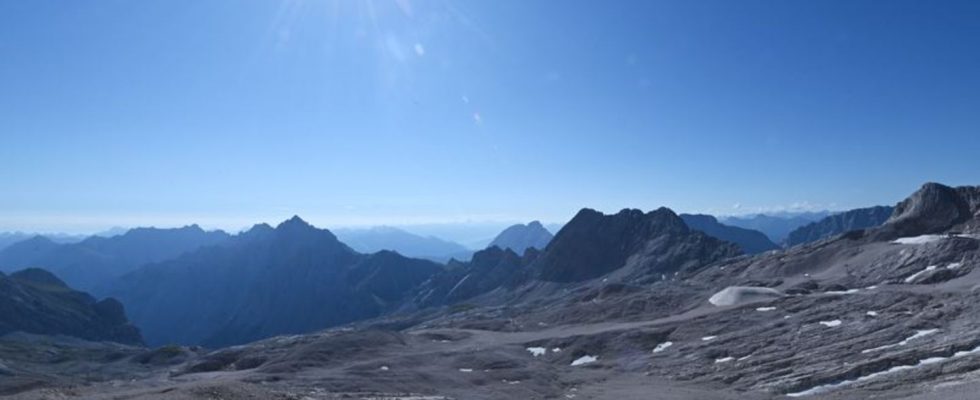climate crisis
Climate change: “Eternal ice” before melting
The sun shines over the Zugspitzplatt formed by glaciers. photo
© Angelika Warmuth/dpa
The last German glaciers belong on the Red List – there is no longer any rescue for them. At the end of July, the churches on the Zugspitze celebrated a requiem. A little protection from above actually came – if only briefly.
In the middle of summer: snow on the Zugspitze. Visitors from the valley were amazed when they arrived at the top of a winter landscape in early August. But for the rest Glacier on Germany’s highest mountain, the white layer was good. The snow reflected the sun’s rays and at least protected the melting ice a little bit.
The measurements by the scientists from the Bavarian Academy of Sciences (BAdW) for this year are still pending. They don’t want to examine the thickness and spread of the last glaciers until autumn. However, experts are already assuming that the ice on the Blaueis and Watzmann glaciers in the Berchtesgaden Alps, as well as the Höllentalferner and northern Schneeferner on the Zugspitze has lost substance again this summer. Her disappearance is only a matter of time.
Ice movement stops
Last year, the southern Schneeferner lost its status as a glacier. At around one and a half hectares, it was half the size it was four years earlier – and it no longer flows. Without ice movement, science no longer assumes a glacier, explains glaciologist Christoph Mayer from the BAdW, which prepares a glacier report for the state government every few years.
Even now, the two largest glaciers in Bavaria – Höllentalferner and Nördlicher Schneeferner, each with just over 16 hectares, are only half the size of the Oktoberfest grounds. They also lost a lot, according to the last glacier report from 2021, both had a volume of 1.7 million cubic meters. However, according to Mayer, the report describes the condition of the glaciers in 2018. Experts give the German glaciers around ten years. But it could also go faster.
Requiem as a wake-up call
In July, representatives of the Protestant and Catholic churches invited to the requiem for the “dying” northern Schneeferner in Germany’s highest church, the Visitation of the Virgin Mary on the Zugspitzplatt. It should be a wake-up call with a view to the climate crisis and the dangers for nature as well as for humanity. The faithful celebrated the death of the Northern Schneeferner with memorial pictures for the glacier, prayers and blessings – although according to the current forecast, this glacier still has at least seven years ahead of it before it loses its status.
The two glaciers in the Berchtesgadener Land are more threatened. They’re only about five acres. “The ice reserves might be enough for another two or three years if we continue to have summer like last year,” says Mayer. The summer of 2022 with weeks of sunshine was “devastating”. According to scientists, the melt last year was around 50 percent stronger throughout the Alps than in an average year.
At the Watzmanngletscher in the Berchtesgaden Alps, the decline is least visible because it lies in a hollow. The loss on the surface is therefore less noticeable. It is also partially covered by rubble, which makes it difficult to determine its size, but also partially protects it from melting.
protection for a few days
Cold snaps in summer sometimes put a protective layer of snow on the ice for at least a few days. White flakes used to be more common in the high mountains, even during the bathing season. Now, the increasing lack of precipitation as snow is a major factor in the accelerated disappearance of the ice. “The melting is even faster because the glacier is no longer protected by the snow cover,” says Laura Schmidt, science communicator at the Schneefernhaus environmental research station on the Zugspitze. She sees the shrinkage every time she looks out the window. “Northern Schneeferner has lost a lot of volume in recent years.”
In addition to the snow in August, the late snowfall in spring also provided a small protective layer this year. Nevertheless, according to Mayer: “The days are definitely numbered.” Instead of snow, rain that is above 0 degrees, high humidity and long periods of sunshine – according to Mayer, these are other factors for the melting of glaciers in addition to general global warming.
The Höllentalferner is doing relatively well, recently measuring 16.7 hectares. It, too, lies in a deep hollow and, not least because of its location, is regularly fed by avalanches, at least in the upper part. The scientists assume that he will survive the longest – it could be another 15 to 20 years.

